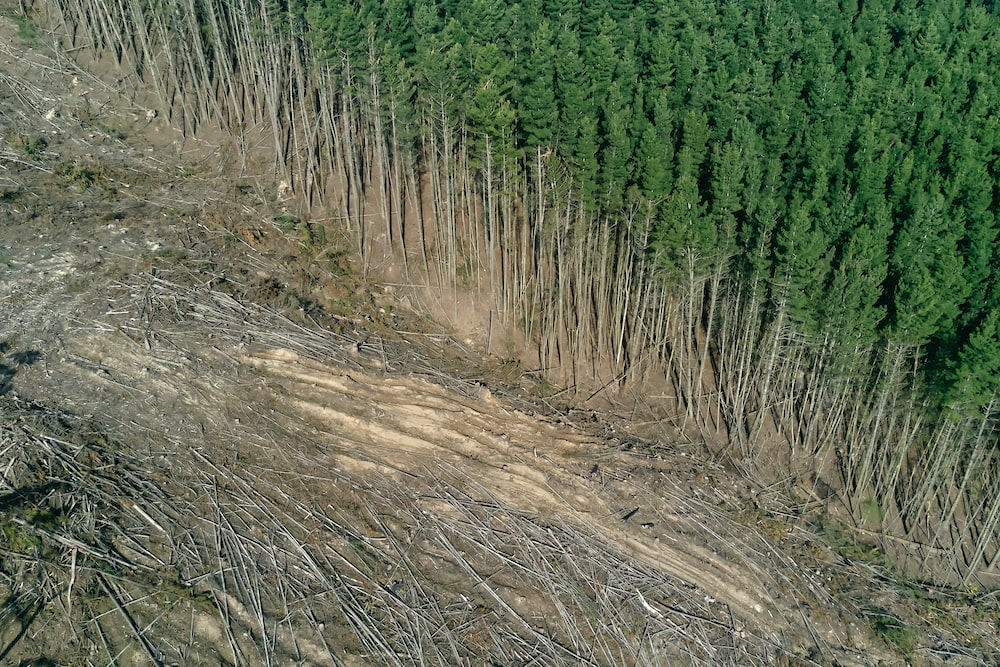
Forests play an important role in climate regulation, and their depletion is accelerating climate change. They limit the amount of CO2 in the atmosphere, improve water quality and availability, preserve biodiversity and regulate temperatures.
During photosynthesis, trees store the CO2 present in the atmosphere and convert it into carbon, which is released in the form of wood and vegetation. At a rate of 20 tonnes of CO2 per tree over its lifetime, the world’s forests store over a trillion tonnes of carbon, twice the volume present in the atmosphere.
Conversely, when forests are destroyed or disappear, they become a source of greenhouse gases, as the stored CO2 is released into the atmosphere. According to the Food and Agriculture Organization of the United Nations (FAO), the destruction of forests releases around 6 billion tonnes of CO2 into the atmosphere every year.

Forests also ensure the viability of the central areas of continents by storing and releasing water. Without this phenomenon, the water that flows into the seas and oceans would evaporate and turn into clouds, which would only travel a few kilometers from the coast before turning into rain.
Only coastal areas benefiting from rain would be viable, while inland areas would be dry. The forest ecosystem, and in particular the humus in the soil, retains water and releases it when temperatures rise, transforming it into clouds that are pushed inland, where they turn into rain and make the land fertile.
In Europe, for example, forests release 2,500 m3 of water per km2 into the atmosphere. Studies tend to show the importance of natural forests over logged forests. Students at the University of Aachen in Germany, for example, have demonstrated a temperature difference of 10˚C between a natural beech forest and a coniferous forest used for logging, just a few kilometers apart.

This difference can be explained by the amount of biomass present in natural forests, which helps retain water. As the water evaporates, it cools, enabling the forest to regulate the temperature in its immediate environment.
The usefulness of forests is therefore a strong argument in favor of limiting deforestation. There are natural factors behind deforestation, such as certain fires or diseases, but there are above all human factors. A report published by the FAO in 2016 estimates that around 80% of deforestation is due to agriculture and livestock farming, 8% to infrastructure construction, 6% to mining and 5% to urbanization.Above all, deforestation threatens global biodiversity, as forests are home to a large number of animal and plant species, some of them rare and fragile. Forests also make soils richer in organic matter, useful for agriculture, and more resistant to weathering and erosion.
Deforestation thus favours landslides and floods. Less forest also means less CO2 stored by trees, and therefore a worsening of the greenhouse effect. It is estimated that around 11% of CO2 emissions resulting from human activities come from deforestation.Some areas of the planet are more affected by deforestation than others, notably because of the size of their forest areas and their economic development. These include South-East Asia, the Amazon and Africa. The Amazon, the planet’s green lung given its capacity to store carbon and produce oxygen, is said to have lost 20% of its surface area since the 1960s. Until the 90s, deforestation was mainly linked to industrial projects, infrastructure construction and subsistence farming.
Since the 200s, deforestation in the Amazon has been increasingly linked to the development of intensive agriculture and livestock farming. According to the FAO, livestock farming and agriculture for livestock feed are now responsible for almost 80% of deforestation in the Amazon rainforest.
Deforestation in Southeast Asia is concentrated mainly in Indonesia and Borneo. According to the FAO, Indonesia lost 3 million hectares of forest between 1990 and 2000, and a further 6 million between 2000 and 2010.

The main reason for deforestation in this area is palm oil production, and the FAO estimates that until recently and the introduction of new regulations, 80% of deforestation was illegal. Africa is a more deforested area than Asia, with around 2 million hectares of forest lost every year, but this mainly concerns the subsistence agriculture of local populations.
According to the FAO, 13 million hectares of the world’s 4 billion hectares of forest – around a third of the total land area – are lost every year. While some areas are losing forests, others are seeing their forest area increase. This is notably the case in Europe, which gained over 7% in forest area between 1995 and 2005, while Central America lost around 19% at the same time.
According to the WWF, the main reason for deforestation remains the transformation of soils into farmland, with the organization estimating that 1/5 of the Amazon has disappeared and that 40-55% is expected to disappear by 2050. To compensate for deforestation and replace primary forests, many countries are reforesting. Since the 90s, around 3 to 5 million hectares of forest have been replanted every year, but some indicators prefer not to take replanted forests into account when measuring deforestation, and instead assess the disappearance of natural forests alone.
Between 2010 and 2015, natural forests lost 6.5 million hectares per year. Over the same period, the country that reforested the most was China, with 1,542 thousand hectares, according to the FAO, even though forests represent only around 20% of its land area, compared with 58% for Brazil and 38% for Canada, for example.In France, forests, which cover 30% of the national territory, will also be transformed, with certain species disappearing, as has already begun in certain fragile forests, notably in Alsace, as Brigitte Musch, a geneticist in the research, development and innovation department of the Office National des Forêts, points out.
The phenomenon is accelerating, particularly in the forests of central and eastern France, such as the Vosges and Bourgogne-France-Comté. In this region, for example, beech is particularly threatened. In other regions, however, it is coniferous trees such as spruce and fir that are threatened and no longer adapted to the changing climate of the regions concerned.




